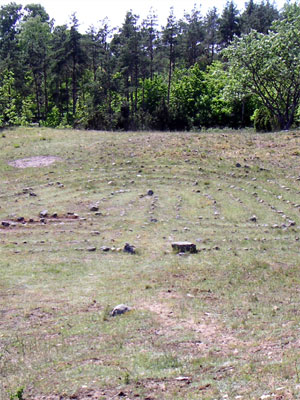
The Troy Town Majbacken lies at Petarve (municipality of Garda) on the island of Gotland, and is approximately 150 years old. This classical labyrinth is stretched a little bit in the height and in the width. It looks somewhat angular.
“The Scandinavian Troy Towns are very old classical labyrinths in the shape of stones laid out in free field. In Germany we have still 4 historic labyrinths (Graitschen, Steigra, Hannover, Kaufbeuren), in England there are 8.
There are about 300 historic, passable stone labyrinths in Sweden, and therefore most of them worldwide. Maybe they are amongst the first in history that could be walked. It is difficulty to say something sure about their age and meaning. Some are probably more than 2000 years old, many 500 years, and some only 100 years. But nevertheless all of them are older as the new labyrinths built worldwide in the last 20 to 30 years. So we may look at the Scandinavian countries as the home of the labyrinth.
In the following you will see the Swedish labyrinths with the eyes of a surveyor and civil engineer. I am interested, where exactly the labyrinths are situated (by GPS), how they are looking like nowadays, which is the pattern and geometric design behind them. Maybe one could call it the search for the ideal line.
Then I think about how to make one with simple measurement methods. Probably they have been built this way. All you need should be some pegs, a ruler, and a rope.”
[credit]
Predominantly Scandinavian “Troy Towns” are labyrinths with a comparable design, but were built by arranging stones on the surface of open fields. The name references the Troy Game, “A solemn ritual performed at irregular intervals by the ancient Romans to signalize their alleged descent from the Trojans: notable for the interweaving labyrinthine maneuvers executed by youths on horseback,” although scholars cannot confirm the true meaning of these sites, some of which date back 2500 years.
